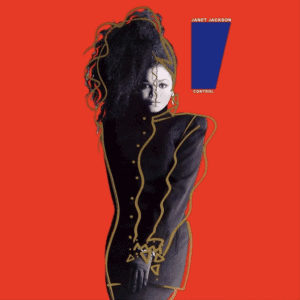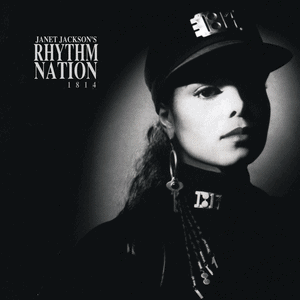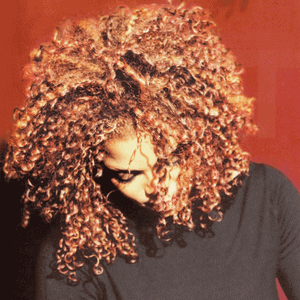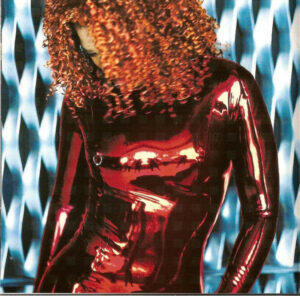By Kyle Johnson
What’s goin’ on people. Why is it that no one talks about Janet Jackson anymore? Nowadays, even if people do, it’s as if they’re talking about a ghost. How did one of the most famous women on the planet become detached from all music conversation? Lemme go on for a minute.
Her profile has diminished so much in the past 10 years or so, that it feels like a musical conspiracy or something. It’s at a point where both young and old only remember her for the 2004 Super Bowl incident (which I’ll get to later). A damn shame. Even contemporaries like Brittany Spears, Mariah Carey, Madonna, and Kylie Minogue still protrude the popular domain today, for one reason or another. (We’ll see some good things—Kylie’s still making new records and much of her past work has undergone a critical reevaluation; and of course, Brittany Spears winning her conservatorship case in 2021. Then the bad things… i.e. Madonna’s new face; and Mariah Carey being the ambassador of Christmas every year for only a single song: even if that song’s great, her Christmas image is a far fall from being one of music’s best selling artists during her peak in the 90s.) It’s such an odd thing because even older contemporaries like Tina Turner and Whitney Houston get tossed around more than Janet does, especially when she has released more artful records than everyone listed and outsold just about everyone except for Mariah Carey and her brother.
With everything already said, I feel that people have forgotten a few statistics: Janet Jackson’s had 28 Top 10 singles, including 10 #1s; she holds the record for the most consecutive Top 10 entries by a female artist (18); Rhythm Nation 1814 is still the only album in history to notch #1 hits in three separate calendar years, and the only one to score seven Top 5 singles. (Even Thriller had a couple that peaked around #6 or #7.) Then she, twice, signed the largest recording contract, in history, contemporaneously: once in 1991, at 24 years old, for $40 million (to be surmounted by her brother days later for $60 million); then again, she renegotiated her contract with Virgin for $80 million prior to the release of The Velvet Rope in 1997. And hell, Billboard’s latest Hottest Hot 100 Hits book lists four of the five biggest selling singles by the Jackson family are by Janet, not her brother Michael. So yeah: she was huge.
As the youngest member of the Jackson family, Janet grew up under the unilateral jurisdiction of her father, Joe Jackson, and the domineering popularity of her brothers’ new group, The Jackson 5. Coerced into making two faceless pop records, 1982’s eponymously titled Janet Jackson and 1984’s Dream Street that did nothing chart wise, a series of events commenced that teased her world domination: Janet’s exhorted desire to estrange herself from her family (really her imperious father), producers Jimmy Jam and Terry Lewis being fired by Prince, and the producers needing a new vocal protégée. With that, Janet’s Control, her first real debut, toped the 1986 Billboard charts with five Top Five Singles and “When I Think of You” became her first Number One.
Control (1986):

Control, her first album with Jimmy Jam and Terry Lewis, is definitively her tightest album she’s ever put out. A set of nine songs where the only filler is the 80s run-times (being the decade of sumptuous excess). You won’t find a more voluble, blunt, and in-your-face record of the decade. The beats here take on monstrously-maximalist form and violently contrast with the smoothie-ness of 1993’s Janet.’s plush-laden beats. Even here, you can hear the influence Janet has had—the skits that proceed songs like “Control” and “What Have You Done For Me Lately” became a Hip-Hop staple in the late 80s and 90s; and the harshness of the beats here are the anti-agent of the atypical 80s cheesiness that hallmark the decade’s pop-scape.
(Pivotal themes of Janet’s records, particularly her Big Four, is that they always centralize around themes of reinvention and control. Her entire career prior had been orchestrated by her father; he never even gave her a choice in the matter of being in the music industry. Her famous annulled marriage to James DeBarge would be a catalyzing moment for the feud between Janet and her father. And with the release of Control, she declares herself as her own woman, a singular woman, without the help of her family. And THAT served as her first reinvention. And to think she was only 19 years-old when this came out. And I already thought myself a failure when thinking about Kate Bush’s The Kick Inside!)
Rhythm Nation 1814 (1989):

In 1989, Janet reinvents herself again on Rhythm Nation 1814, wherein Janet becomes a socially conscious philanthroper as a response to various tragedies in the media.
Rhythm Nation 1814 laid the groundswell for hallmarks in Janet’s career: 1) Janet’s omnivorous musical appetite—that enables her genre mixing musical tendency to astounding success; on Rhythm Nation, Janet bleeds Industrial beats onto funky grooves, with overt nods to 70s Soul music, making one of the most singular, and iconic, dance records of the 80s and beyond; 2) Interludes: Janet’s releases, beginning with this album, are chuck full of criticized interludes, though I don’t see them as useless as others make them out to be (HUGE R&B records like Lauryn Hill’s The Miseducation of Lauryn Hill, and Beyoncé’s Lemonade are just two examples that use interludes like Janet did before them) 3) Sex appeal: the back half of Rhythm Nation features all the ballads on sequence (another tendency of Janet’s from Control I actually don’t like for one reason: the uproar stops); and here is where she starts bringing in her sexuality, that presupposes her 90s image: “Ready to give all my love (ooh) / Won’t hold back / Someday is tonight (someday is tonight) / Let me make your dreams come true (let me make) / Don’t hold back (let me make) / Someday is tonight (let me make your dreams come true, oh, yeah) / Right now” ooze sensuality, with her nasally, breathy delivery, and especially her intermittent “mmmmhmm’s”.
A point brought up by another reviewer is that Janet became the Queen of the Ad-Libs here; the ‘SAYIT’ of “Rhythm Nation” and ‘LET’S GO!’ on “Escapade” are like mini-supernovas of hooks and bursts of energy. And one last thing I want to mention is that Rhythm Nation is the quintessential New Jack Swing record; it was the groundswell for R&B for years until the Soulquarians combined the Hip-Hop ethos into its atmosphere and Timbaland conflated stuttered production and electronic pyrotechnics into its beats and grooves at the turn of the century. Even so, for the next five or so years, R&B artists were copying this; even Michael, on his 1991 record Dangerous, takes this sound from his sister’s record.
With the enormous success of Rhythm Nation Janet, kin to Bowie hopping off the Glam Rock ship after 1974, realized the New Jack Swing sound that she made for herself, had to go.
Janet. (1993):

In 1993, came the release of Janet. Preceding it saw Jackson in the throngs of a high-profile bidding war. In 1991, her original label A&M sought to renew her recording contract, while others, such as Atlantic, Capitol, and Virgin all competed to sign her to their labels. After meeting with Virgin, she signed with them at an estimated $40 million, making her the world’s then-highest paid musical act at the age of 24.
And with that, she reinvents herself again by dropping her famous surname in favor of becoming Janet. stating once again, her own autonomy and further estranging herself from her famous family. On Janet. she unleashes her febrile sexuality, becoming a sexual-seraph—singing deep-throbbed sex anthems over titillating grooves and fertile beats. The Janet. album sees Jackson debasing her political posturing in favor of declaring sexual liberation; the album cover is coyly taken from her famously racey and topless Rolling Stone cover, making goods on the promise of sexual emancipation. Jackson’s transformation has been linked to that of Marvin Gaye; just as Gaye moved from What’s Goin On to Let’s Get It On, from the austere socio-political commentary to exuberant sexual celebration, Janet, every bit as serious-minded as Marvin, moved from Rhythm Nation to Janet., her statement of her own sexual celebration.
With the turn of the decade, Janet proved again that she was a sonic magpie, quickly embracing the shifting sounds of 90s Contemporary R&B—Neo-Soul, Trip Hop, House, Baggy, Hip-Hop, and, in general, Electronic textures, that would embellish Janet. and later, The Velvet Rope.
Janet accomplished her feat: creating the quintessential 90s sex album with Janet.; then, in 1997, she does it again. And before I continue, something to note is that Janet has always been flacked for her singing, or specifically her tiny voice. Except I find it difficult to critique, especially since her, and Jimmy Jam and Terry Lewis, were all aware of this and worked around it. And actually, I think that by becoming a sexual champion, she used her thin voice to create her own breathy, intimately salacious timbre that quickly made her one of the most erotic singers of the 90s. (And hell, her style of quietly humming into the microphone, sounding as innocuous and pretty as possible that no one can complain over… Janet’s singing the indie thing before the indie thing! And Janet was doing this in ’86, years before indie music became mainstream.)
I think it’s crazy that Michael Jackson has been inducted into the National Museum of Dance and Hall of Fame, making him the first and currently, only recording artist to be inducted, and not Janet; by this point, it was an established fact that Janet was as ferocious a performer (and as great of a dancer, but people too afraid of heresy) as her brother, Michael. Off stage, both present themselves in soft-spoken utterances and insular body language; but on-stage, they turn on like no one’s seen before or since their time. If we’re talking influence, yeah people have mimicked and copied Michael’s moves to death – into parody territory nowadays – but Janet’s dancing is more subversive than that. I don’t mean to say that her dancing has more depth than Michael’s or anything like that, I mean that Janet’s influence isn’t as palpable’s as Michael’s simply because his moves have transmogrified into the public domain. (If you see anyone kick in the air, and move their leg, toe stand, crotch grab, or moonwalk, everyone in the world knows that’s Michael Jackson.) But how about this as a counterpoint: every single time you’ve watched celebrities dancing erotically, that is because Janet did it first. Not that Janet invented it, but she did it in front of the whole world first, and none before her did with as much febrile intensity as she. The movement Janet started with the If… music video is undeniable. Pop stars today continue to try to match and surpass the bar Janet set in the 90s, some by over performing, others by getting downright embarrassing. Michael’s incredible, but let’s give Janet her due credit too.
The Velvet Rope (1997):
Between 1993-1997, Janet released “Scream” with her brother Michael, that’s set to one of the most talked about music videos in history. For years, Michael had been trying to sway Janet into doing a duet, though she refused every time because she knew she’d get accused of using her brother’s name for success. But with the first wave of allegations in 1995, that pervaded into the public eye, Janet finally acquiesced, as an action of sibling solidarity. (With the two together on screen, the world finally put to rest that Janet was clearly the more outrageous of the two. She played in Michael’s field and outshined him: from peeing standing up, pulling off androgyny—while retaining her feminine sexual power—and flipping off the camera, her presence was a rebellious, gamine, force. She was also the one that insisted using the f-word, initially against Michael’s wishes. And, even though it was Michael’s song for his album, he asked her to produce the song and organize the music video). Janet also renegotiated her recording contract for another record breaking $80 million becoming, for the second time, the highest paid musical act in the world. Afterwards, she experienced a mental breakdown, stemming from childhood trauma, body dysmorphia, depression, and self-harm. These events set up for the release and inspired much the themes that dominate her 1997 record, The Velvet Rope.

For the first time in three albums, Janet isn’t reinventing herself again, rather she extrapolates on the self she explored on Janet. The sex gets more and more seditious, rather than getting more explicit. But this time, we get more of Janet as human being than we’ll ever get again. And here, we get her psychology: she felt the repercussions of a Jackson-childhood reverberate into her adult life; and she was always overshadowed by her brother and therefore felt ashamed of her success, and felt inadequate. The problem was this: though she was frickin’ Janet Jackson, with all the unprecedented accomplishments I’ve talked about above, she was just never Michael Jackson. Could you imagine that?
The sex music here discharges a sexual freedom instead of a liberation. While Janet. is a celebration of the act of sex, The Velvet Rope posits more avenues within the sexual route, and therefore sexual freedom. “Rope Burn” is about, well, let’s say Janet wrote the 30 year sequel to The Velvet Underground’s “Venus in Furs”; “My Need” extolls non-committal sex; “Go Deep” is one of the nastiest party-sex anthems (only Janet could get away with singing “I’m getting freaked from behind / And I don’t even mind); and “Anything” perpetuates the sex-as-spiritual-journey amorous adventure.
The album notably features queer-leanings: “Free Xone” demands free love for all relationships and tackles homophobia; “Tonight’s the Night” is Janet’s queer-coded rendition of Rod Steward’s song, keeping the ‘her’ pronoun, knowing full well people will assume Janet a lesbian for doing so; and, of course, “Together Again,” a requiem for Janet’s friend, a victim of AIDS; and possibly, even “You” (“Spent most your life pretending not to be / The one you are but who you choose to see). (The album was banned in more conservative countries as a result of the queer themes). These songs not only reinforced Janet’s status as a sex symbol but now as a gay icon. Her look changed entirely too. Accompanying the album, Janet unveiled an edgier image, flaunting dyed red hair and tattoos along her neck, wrist, foot, back, and lower thigh; also, she acquired nipple, septum, and labia piercings.


Compounded onto queer themes are laments of domestic violence, depression, and self-worth. In every way possible, The Velvet Rope was Janet’s album. And the genre hopping we’ve seen her entire career up til this point epitomizes here. The opening title track samples Mike Oldfield‘s “Tubular Bells” and The Exorcist, with the blurting guitars/synths that maneuver into the downtempo keyboard line. Not many of Janet’s contemporaries would’ve included that violin solo, that soars to exceptional heights. “Empty,” an IDM song on an R&B album (Janet was really breaking the rules here) has its heavenly drum programming, making goods on the preceding “Online” interlude; with its empyrean electronic soundscape, I just want to hook up to all those bolts and wires and be taken to its Internet bliss. (I argue that both of these songs fully realize Alternative R&B twenty years prior, a genre defined for its emphasis on sputtering, syncopated beats and ethereal electronic textures. And hell “Empty” sounds like proto-footwork too; it even has dubious lyrics about the nascent online-dating phenomena that are extremely prescient for ’97.) “You” is funky stomper; Janet ad-libs sounding like Erykah Badu and contains its quasi-Jungian dimensions in the lyrics and the layers at which Janet pronounces them. “Got ‘Till It’s Gone,” the album’s premiere single, features one of the most legendary collaborations: Janet Jackson, Joni Mitchell, Q-Tip (A Tribe Called Quest), on a J Dilla beat. Pivoted around the “Don it always seem to go / that you don’t know what you got until it’s gone” sample, Janet and Q-Tip feign improvisation around its hip-hop beats. (Also worth note of the Afrocentrism from the accompanying video, which depicts apartheid-era South Africa and features Jackson with her now-iconic natural, asymmetrical hair-do.)

“Go Deep” with its college-chorus of “We go deep / And we don’t get no sleep / ‘Cause we be up all night / Until the early light”, is a R&B masterpiece. The funky flexatone and intermittent mouth harp repleted in its chorus’s (again, I don’t know who else would’ve thought of that) puts itself down a should-be dancefloor staple. Following up is the jazzy “Free Xone,” the song freaks during the chorus’s with its obtuse guitar line and embellishments of electronic breakouts. The horns on the third chorus might be one of the most delicious things to ever grace pop music. So damn groovy. “Together Again” is a deep house-bounce that was the international number one hit. “What About” oscillates between breezy muzak on the beach and teeth grinding, seething anger over electric guitar. “Tonight’s The Night,” is a trip-hop laden ballad with gorgeous harmonies. “I Get Lonely,” was another huge hit – more evidence to Janet’s effortless bouts of turning melancholic subjects into dancefloor staples – its got one of the best hooks on top of a throbbing bass, and, of course, an unforgettable chorus. “Rope Burn,” a tribute to Janet’s propensity for bondage and BDSM, is a slow sex jam; Janet sings with a fleeting longing, waiting for the anticipation of danger and fantasies.
The release of The Velvet Rope, in spite of selling three million and going multi-platinum, was a disappointment up against Janet.’s six million copies sold (let alone Rhythm Nation‘s twelve million). The Velvet Rope, I argue, is not only one of the most influential R&B albums to date but is most representative of the college experience. With its freeform, freewheeling sexuality, lyrical themes of a torn-up identity, courageous experimentation, dance R&B anthems; its fearlessness in its hodgepodge ethos, artful leanings, hipster collaborations, and an enduring legacy as the soundfont for today’s Alternative R&B; it aligns itself to all the particulars of being a college student. Without The Velvet Rope artists like Solange, The Weekend, Blood Orange, SZA, Frank Ocean, Kelela, and, of course, Janelle Monáe would not exist. (The latter of whom honored Jackson at the Rock n’ Roll Hall of Fame in her best Rhythm Nation attire and gives overt nods to The Velvet Rope on her 2018 album Dirty Computer and lately 2023’s The Age of Pleasure.)
I think what I find so profound, and refreshing, in The Velvet Rope, or just in Janet’s own pop-ethos, is her honesty. Many people compare the record to Madonna’s 1998 Ray of Light – for being artier-leaned, experimental pop records of the late-90s, done by globalized sex symbols of the music industry, that wrote about the blackest depths and most euphoric joys within the human heart (and we haven’t even talked about Kylie Minogue’s Impossible Princess) – but I just can’t get behind that comparison. For what Madonna was in the 90s – a scenester grasping for recognition in the art crowd – Janet’s genre hopping and burgeoning musical voice feel authentic. For while Madonna was whispering and moaning over Downtempo grooves and Trip-Hop beats – because that’s the hipster thing to do (I really miss her 80s yelps and gallops) – Janet’s interpolation of Hip-Hop instrumentation, electronic textures, Art-Pop, and Neo-Soul, into her already-growing R&B style, were merely modes of communicating her feelings. And, to dig into the queer themes present on The Velvet Rope here, there has to be a comparison to David Bowie’s The Rise and Fall of Ziggy Stardust and the Spiders From Mars; not just because both albums reveal hyper-sexual personalities, where both protagonists are bathed in bodies possessed by men and women, but rather due to both albums’ aptitude to impart self-actualization. Let’s be honest: if you ever were mangled in confusion, misunderstood by everyone, lonely, queer, and/or – quite frankly – suicidal in high school, The Rise and Fall of Ziggy Stardust and the Spiders From Mars probably saved your life; and it did that for three reasons: you were freed, you were understood, and you weren’t alone. In every single one of these ways, The Velvet Rope does the exact same thing. Both records are irrevocably confrontational with identity dysmorphia and actualizing identity, within and beyond its queer themes, and puts them in a special partition in the pop-panthenon for their honesty and freeing power. And to further add, Bowie had close to no pedigree before Ziggy struck the UK and made him a superstar; he had nothing to lose by releasing such a, then considered, lewd and lyrically transgressive record. Janet on the other hand, on the heels of renegotiating an $80 million contract, was the most famous women on the planet and had everything to lose by releasing something like The Velvet Rope. Could you imagine something like that happening today? Janet took a chance that could’ve cost her entire career – risking public sleuthing, embarrassment, and defacement – in order to be herself. Just doing that, might be the most Janet Jackson thing in the world.
God I love this woman so much.
Legacy:
Following the 2004 Super Bowl incident came the denunciation of Janet Jackson as a public figure. As I said earlier, people young and old only seem to remember her for that incident. She received far more blame than Timberlake had and suffered the consequences—Janet’s 2004 record Damita Jo was blacklisted globally; she was denied appearing at the Grammys and multiple interviews; and the previous year, to honor Jackson’s legacy, Disney erected a Micky Mouse statue donning a Rhythm Nation outfit, but was later removed following the incident. In years since, she has received less and less airplay, even on 80s and 90s centric radio stations. Her profile has gratuitously diminished over the years. Only when her 2015 album Unbreakable was released, did people re-evaluate her legacy. It’s odd because contemporaries like her brother and Madonna got their share of public backlash, but never in the way Janet did. This was different because they were never publicly flogged and having radio stations and MTV actively boycotting them like Janet did after this incident.
For me, why I love Janet is simple: her humanness. Everything I’ve detailed out has emblems of the human condition that anyone can connect with: her desire for self-volition, the estrangement from her famous family, working in Michael’s shadow, and being humiliated in front of America, are all obstructions that, at their heart, people can relate with. Not only that, but we’ve seen her persevere—she became successful without her father’s dictatorship or her lineage; Rhythm Nation’s social consciousness aided ailing persons around the world; she’s taken risks with popularity that almost no other artist has ever done; she’s liberated millions of people, sexually and otherwise; as well as being musically prophetic by becoming the harbinger of Alternative R&B. (Even after the Super Bowl scandal, the event notably inspired Jawed Karim to found YouTube when he had difficulty finding clips of it online. That means, Janet Jackson and…Justin Timberlake inadvertently led to the creation of YouTube! They’re more influential than you’d originally think. Ha!) She was chewed up and spit out by the industry; and now, still touring in 2023, we witness her continuing to be the wonderful human being she’s always been.

In short: we’re still waiting for the Janet Jackson renaissance to happen.
And one day, when we still talk about Thriller, we’ll also talk about The Velvet Rope.
And it will happen.

